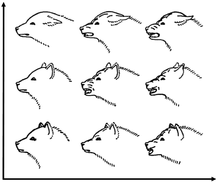Wolf Communication System
Grey wolves have a very complex communication system. They communicate by using body scents, paw glands, body language, yips, and barks. Wolves use their body scent to mark their territory by urinating. Wolves have scent glands in their paws and they will use their paws to place their scent for others to smell.
Wolves communicate by howling, yipping, and barking. Wolves use their voices when other wolves are close and interact with one another. A wolf's howl can be heard as far away as six miles. Their voices are also used to warn other wolves.
The wolves are social animals, and they live in packs. The alpha male and female are the leaders of the pack. The wolves use their whole body from head to tail to communicate with one another. The wolves use their tail, and face to show their confidence and pack rank. An alpha wolf will have his or her tail held higher than the rest.
All pack members must live and work together to survive. The wolves need good communication with each other. An alpha wolf will kill one to three wolves in his or her lifetime.
Visual
The gray wolf's expressive behavior is more complex than that of the coyote and golden jackal, as necessitated by its group living and hunting habits. While less gregarious canids generally possess simple repertoires of visual signals, wolves have more varied signals that subtly inter grade in intensity. When neutral, the legs are not stiffened, the tail hangs down loosely, the face is smooth, the lips untensed, and the ears point in no particular direction. Postural communication in wolves consists of a variety of facial expressions, tail positions and piloerection. Aggressive, or self-assertive wolves are characterized by their slow and deliberate movements, high body posture and raised hackles, while submissive ones carry their bodies low, sleeken their fur and lower their ears and tail. When a breeding male encounters a subordinate family member, it may stare at it, standing erect and still with the tails horizontal to its spine. Two forms of submissive behavior are recognized: passive and active. Passive submission usually occurs as a reaction to the approach of a dominant animal, and consists of the submissive wolf lying partly on its back and allowing the dominant wolf to sniff its anogenital area. Active submission occurs often as a form of greeting, and involves the submissive wolf approaching another in a low posture, and licking the other wolf's face. When wolves are together, they commonly indulge in behaviors such as nose pushing, jaw wrestling, cheek rubbing and facial licking. The mouthing of each other's muzzles is a friendly gesture, while clamping on the muzzle with bared teeth is a dominance display.
Similar to humans, gray wolves have facial color patterns in which the gaze direction can be easily identified, although this is often not the case in other canid species. In 2014, a study compared the facial color pattern across 25 canid species. The results suggested that the facial color pattern of canid species is related to their gaze communication, and that especially gray wolves use the gaze signal in conspecific communication.
Auditory
Gray wolves howl to assemble the pack (usually before and after hunts), to pass on an alarm (particularly at a den site), to locate each other during a storm or unfamiliar territory and to communicate across great distances. Wolf howls can under certain conditions be heard over areas of up to 130 km2 (50 sq mi). Wolf howls are generally indistinguishable from those of large dogs. Male wolves give voice through an octave, passing to a deep bass with a stress on "O", while females produce a modulated nasal baritone with stress on "U". Pups almost never howl, while yearling wolves produce howls ending in a series of dog-like yelps. Howling consists of a fundamental frequency that may lie between 150 and 780 Hz, and consists of up to 12 harmonically related overtones. The pitch usually remains constant or varies smoothly, and may change direction as many as four or five times. Howls used for calling pack mates to a kill are long, smooth sounds similar to the beginning of the cry of a horned owl. When pursuing prey, they emit a higher pitched howl, vibrating on two notes. When closing in on their prey, they emit a combination of a short bark and a howl. When howling together, wolves harmonize rather than chorus on the same note, thus creating the illusion of there being more wolves than there actually are. Lone wolves typically avoid howling in areas where other packs are present. Wolves from different geographic locations may howl in different fashions: the howls of European wolves are much more protracted and melodious than those of North American wolves, whose howls are louder and have a stronger emphasis on the first syllable. The two are however mutually intelligible, as North American wolves have been recorded to respond to European-style howls made by biologists
Other vocalisations of wolves are usually divided into three categories: growls, barks and whines. Barking has a fundamental frequency between 320–904 Hz, and is usually emitted by startled wolves. Wolves do not bark as loudly or continuously as dogs do, but bark a few times and retreat from perceived danger. Growling has a fundamental frequency of 380–450 Hz, and is usually emitted during food challenges. Pups commonly growl when playing. One variation of the howl is accompanied by a high pitched whine, which precedes a lunging attack. Whining is associated with situations of anxiety, curiosity, inquiry and intimacy such as greeting, feeding pups and playing.[
